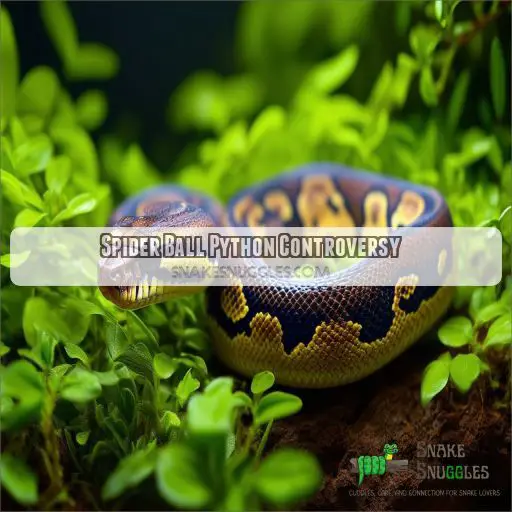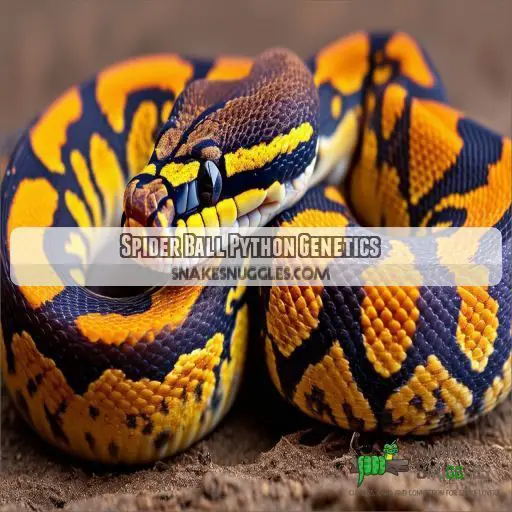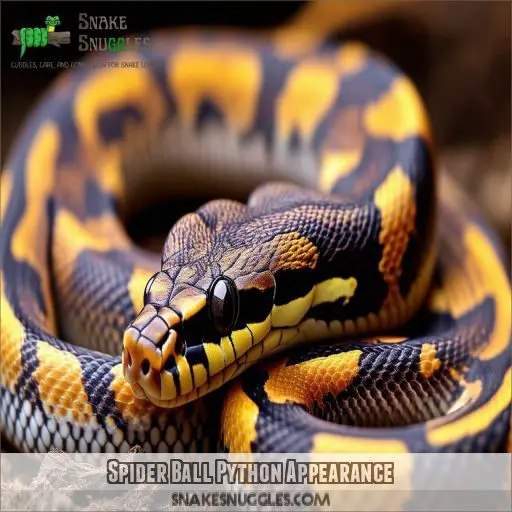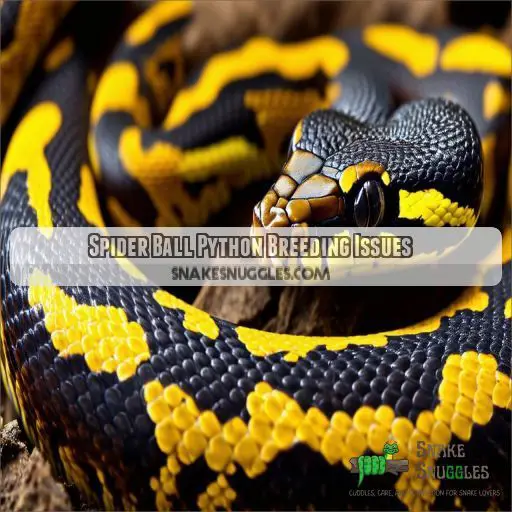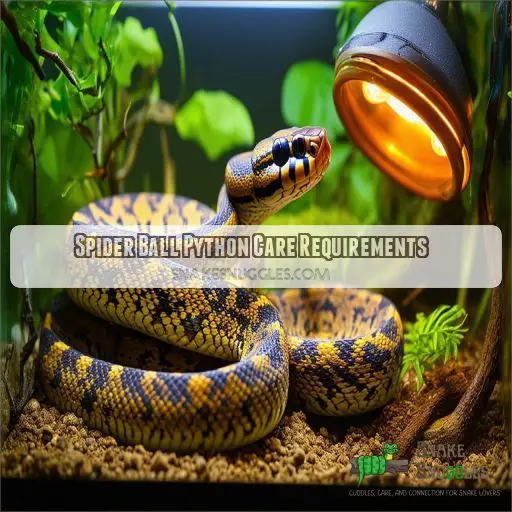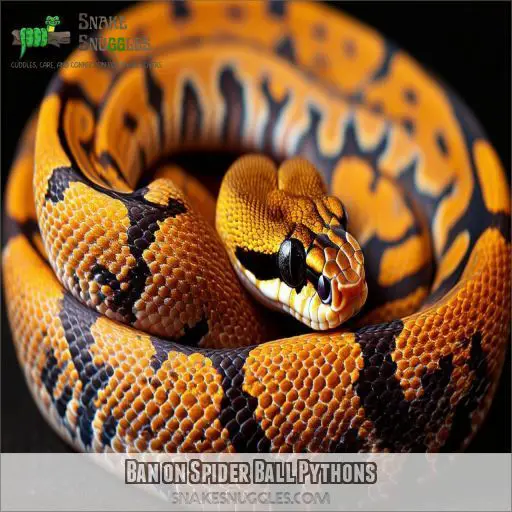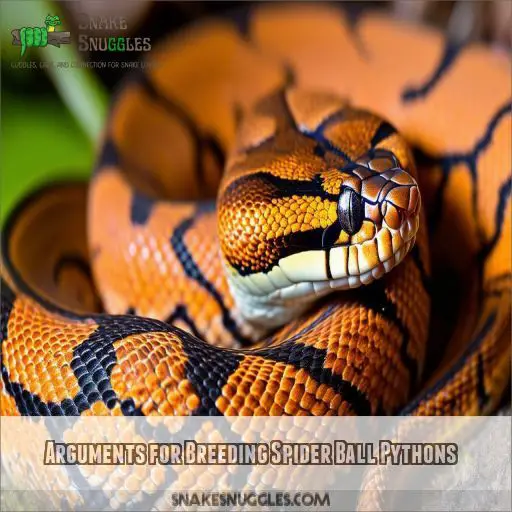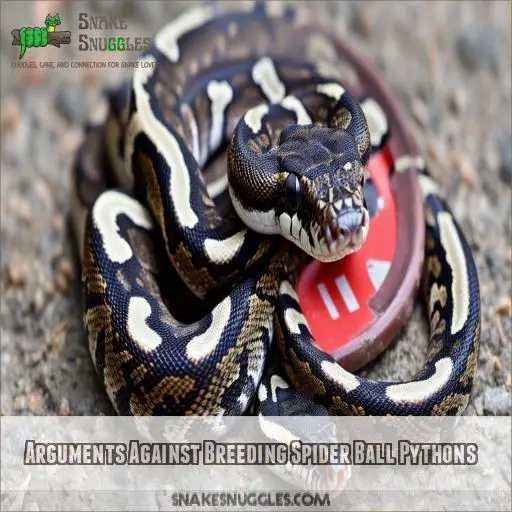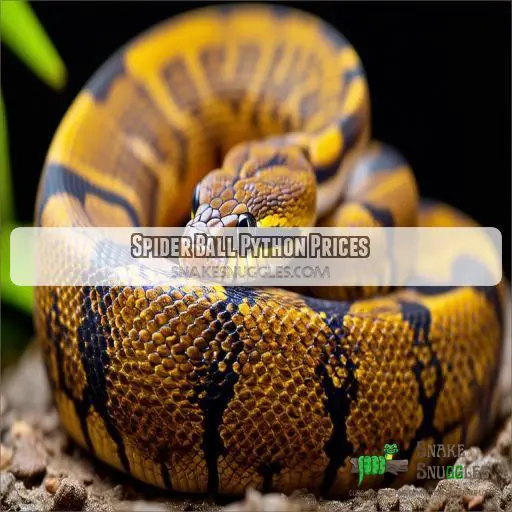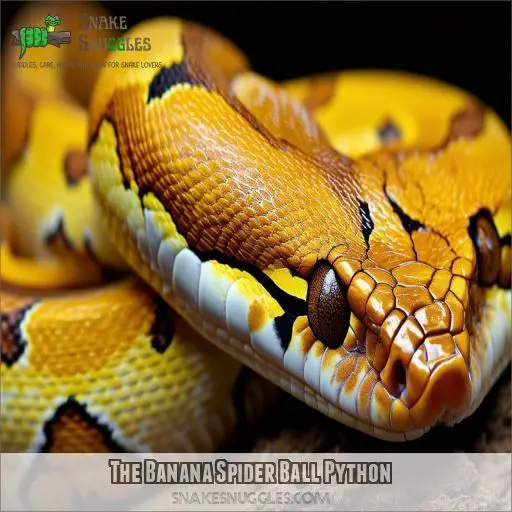This site is supported by our readers. We may earn a commission, at no cost to you, if you purchase through links.
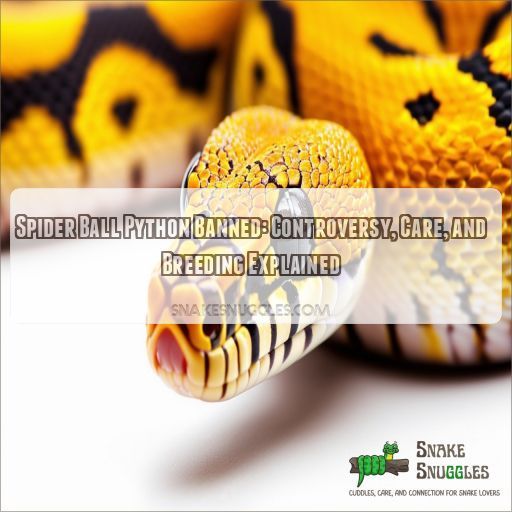 Imagine a python with a web-like pattern, banned from reptile shows. That’s the spider ball python, a morph that’s sparked controversy in the reptile community.
Imagine a python with a web-like pattern, banned from reptile shows. That’s the spider ball python, a morph that’s sparked controversy in the reptile community.
You’ll find this breed at the center of debates about ethics, genetics, and animal welfare. The spider morph’s distinctive appearance comes with a neurological condition called "the wobble," leading to its ban in some circles.
Let’s explore the controversy, care requirements, and breeding issues surrounding these unique snakes.
Table Of Contents
- Key Takeaways
- Spider Ball Python Controversy
- Spider Ball Python Genetics
- Spider Ball Python Appearance
- Spider Ball Python Breeding Issues
- Spider Ball Python Care Requirements
- Ban on Spider Ball Pythons
- Arguments for Breeding Spider Ball Pythons
- Arguments Against Breeding Spider Ball Pythons
- Spider Ball Python Prices
- The Banana Spider Ball Python
- Frequently Asked Questions (FAQs)
- Are spider ball pythons banned in the US?
- Why are spider ball pythons controversial?
- Are spider ball pythons venomous?
- What is the spider ball python mutation?
- How do spider ball pythons behave differently from normal ones?
- Are there any health benefits to the spider gene?
- Can the wobble in spider ball pythons improve over time?
- How do snake breeders identify spider ball python hatchlings?
- What alternatives exist for spider ball python enthusiasts?
- Conclusion
Key Takeaways
- Hold onto your snake hooks, folks! The spider ball python’s dazzling web-like pattern comes with a neurological twist – the infamous "wobble" that’s got the reptile world in a tizzy.
- Talk about a slippery slope – some reptile expos have given these snakes the boot, citing ethical concerns over breeding animals with potential health issues. It’s like trying to unscramble an egg!
- Breeding spider ball pythons? You’re walking a tightrope between unique aesthetics and animal welfare. It’s enough to make even the most seasoned snake handler’s head spin!
- Despite the controversy, these snakes aren’t universally banned. But before you coil one around your arm, remember: with great pattern comes great responsibility. It’s not all sunshine and rodents in the world of spider ball pythons!
Spider Ball Python Controversy
The Spider Ball Python controversy centers around the spider gene risks, particularly the neurological defect known as the spider wobble.
Exhibiting a wobble severity range from light to severe, these pythons face health vs. animal welfare debates. Some expos have outright banned the sale of any spider ball python, citing concerns over the super spider lethality.
This specific gene, leading to severe wobbles, raises ethical breeding practices questions. While many breeders argue these snakes can lead normal lives with proper care, others believe animal welfare should be prioritized.
Understanding both sides, especially the challenges posed by the spider gene, is crucial in making informed decisions about breeding and purchasing these unique reptiles.
Spider Ball Python Genetics
Understanding spider ball python genetics is crucial for prospective breeders. The spider morph is inherited as an incomplete dominant trait, meaning:
- Spider Gene Inheritance: When you breed a spider ball python with a normal ball python, approximately 50% of the offspring will inherit the spider gene.
- Spider Complex: This gene is part of the spider complex, which involves related morphs with similar patterns.
- Genetic Disorder: All spiders exhibit a neurological disorder known as "wobble," affecting their balance and coordination.
- Spider Morph Legality: While some expos have banned spider ball pythons due to ethical concerns, it’s still legal to breed them, raising questions of spider breeding ethics. Always consider genetic testing availability and spider venom safety when breeding.
Spider Ball Python Appearance
The Spider ball python is known for its distinct color variations and markings. While the Spider’s size is generally comparable to other ball python morphs, its unique physical traits have made it a controversial topic within the reptile community.
Color Variations and Markings
Continuing from genetics, you’ll find that Spider Ball Pythons showcase striking appearances. They boast bold black patterns often resembling webs or puzzles. These markings overlay golden "alien heads" along their sides. The belly displays patchy black extensions of the body markings, while the tail has a mostly unbroken pattern. This unique look makes the spider morph highly coveted.
Size
Spider Ball Pythons typically reach 3-5 feet in length, with females being larger. Their growth rates depend on diet and environmental conditions. Key morphological traits include:
- Sexual dimorphism: Females are usually larger.
- Size comparison: Smaller than some other pythons.
- Longevity: They can live up to 20-30 years.
However, the genetic defect causing their head wobble must be considered.
Spider Ball Python Breeding Issues
You owe it to the animals themselves to really, seriously consider the genetic health and welfare implications of working with Spider ball pythons.
Unfortunately, with these morphs, there tends to be some level of neurological defect, from mild wobbling to severe neurological issues that simply don’t promote quality of life. Though the profit potential in selling morphs like this may seem quite inviting, the ethical considerations should always come first.
Husbandry leadership for Spider ball pythons must be implemented exclusively by specialized care. Appropriate animal husbandry of animals should undoubtedly take precedence in captive breeding schemes.
Potential purchasers notice and consider the risks and such intrinsic challenges of keeping a pet of this sort in the case of a Spider ball python. Ultimately, whatever the decision is regarding the breeding and taking on of these two morphs, it must be done with all the right concerns for the animals involved.
Spider Ball Python Care Requirements
Spider Ball pythons require specific care to thrive. Maintain appropriate humidity levels between 50-60% to prevent shedding issues. Heating gradients are critical; provide a warm side around 88-92°F and a cool side around 78-80°F. Use substrate choices such as aspen, cypress mulch, or paper towels for ease of cleaning and moisture retention.
Due to their wobble, spider ball pythons may have spatial awareness and climbing difficulties. Ensure their enclosure promotes safety, avoiding high platforms. Feeding schedules should be consistent, typically once a week, to monitor eating difficulties. Enrichment options like hides and low branches can enhance their well-being, but always monitor for stress.
- Maintain humidity between 50-60%
- Offer a gradient: warm side at 88-92°F, cool side at 78-80°F
- Consistent, weekly feeding schedules
Ban on Spider Ball Pythons
You’ve probably heard about the Spider Ball Python ban, but what’s the real scoop? Some reptile expos and organizations have taken a stand against these snakes due to welfare concerns. The ban isn’t universal, but it’s gaining traction. Here’s a quick breakdown of the situation:
| Aspect | Details | Impact |
|---|---|---|
| Ethics | Welfare concerns | Increased scrutiny |
| Conservation | Genetic diversity debates | Breeding program changes |
| Responsibility | Breeder accountability | Stricter guidelines |
The ban stems from the spider gene’s associated health issues, including drinking difficulties and a tendency to bite non-organic matter. As a potential buyer, you’ll need to weigh the ethical implications against your desire for this unique morph. Remember, related traits might also be affected. While some argue the ban is an overreaction, others see it as a necessary step for snake welfare. The debate continues, shaping the future of ball python breeding and conservation efforts.
Arguments for Breeding Spider Ball Pythons
Despite the ban, some breeders argue for continuing to breed Spider Ball Pythons, citing the importance of responsible breeding practices that prioritize animal welfare and genetic diversity. Despite the ban, some breeders argue for continuing to breed Spider Ball Pythons. They claim that the morph’s unique appearance and genetic diversity contribute to the hobby. Here are three main arguments in favor of breeding:
- Genetic diversity: Spider morph genetics add to the overall gene pool, potentially leading to new and exciting combinations.
- Wobble severity varies: Not all Spider Ball Pythons exhibit severe neurological issues, with some showing only mild symptoms.
- Ethical breeding practices: Responsible breeders can selectively breed for reduced wobble severity, potentially improving the morph over time.
Proponents argue that with proper care and informed ownership, Spider Ball Pythons can lead healthy lives. They emphasize that the Lethal Super gene isn’t exclusive to Spiders and that many popular morphs carry genetic quirks. By continuing to breed, they hope to better understand the genetics behind the wobble and potentially find ways to mitigate its effects.
Arguments Against Breeding Spider Ball Pythons
When you consider breeding Spider Ball Pythons, you’ll encounter strong arguments against the practice. Critics point to the welfare concerns associated with the spider gene, particularly the neurological issues known as "wobble." This condition can significantly impact a snake’s quality of life, ranging from mild to severe cases. There’s also the ethical dilemma of intentionally producing animals with known health problems.
Genetic diversity is another concern, as focusing on spider morphs might narrow the gene pool. The pet trade ethics come into question when selling snakes that may require specialized care, like those found on reptile-specific platforms.
Super spiders, which are lethal, raise legality issues in some areas. Wobble severity can be unpredictable, making it challenging for breeders to ensure healthy offspring.
These arguments have led some reptile expos and breeders to ban or discourage spider morphs, prioritizing the overall health of ball pythons.
Spider Ball Python Prices
When considering a Spider Ball Python, you’ll find their prices can vary widely. Factors like age, size, and specific color patterns influence the cost. Generally, you can expect to pay anywhere from $50 to $500 for a Spider morph. However, prices may fluctuate based on:
- Market demand and breeder reputation
- Combination with other sought-after morphs
- Overall health and quality of the specimen
It’s crucial to remember that the initial purchase price is just the beginning. You’ll need to factor in ongoing care costs, including housing, heating, and feeding. While Spider Ball Pythons can be more affordable than some designer morphs, their potential health issues may lead to higher veterinary expenses down the line. Always prioritize ethical breeding practices and the snake’s well-being over price when making your decision. Research thoroughly to ensure you’re getting a healthy pet from a reputable source.
The Banana Spider Ball Python
You’ll find the Banana Spider Ball Python to be a captivating morph that combines two distinct genetic traits. This unique blend results in a stunning snake with vibrant coloration and the characteristic spider pattern. Here’s a quick breakdown of what you need to know:
| Trait | Banana | Spider |
|---|---|---|
| Genetics | Co-dominant | Dominant |
| Color | Yellow/cream | Reduced black |
| Pattern | Freckles | Webbing |
| Inheritance | 50% chance | 50% chance |
| Health Concerns | None specific | Wobble |
While the Banana gene doesn’t carry health issues, the Spider gene’s wobble remains a concern. Future availability may be limited due to breeding bans at some events. Despite this, the Banana Spider’s striking appearance continues to attract enthusiasts. When considering this morph, weigh the aesthetic appeal against potential health implications. Remember, responsible breeding practices are crucial for maintaining the well-being of these fascinating creatures.
Frequently Asked Questions (FAQs)
Are spider ball pythons banned in the US?
You’ll find that spider ball pythons aren’t banned nationwide in the US. However, some reptile expos have prohibited their sale due to concerns about neurological issues. It’s legal to breed them, but controversy surrounds their welfare.
Why are spider ball pythons controversial?
You’ll find spider ball pythons controversial due to their neurological issues. They’re known for a "wobble" that affects their balance and coordination. This condition raises ethical concerns about breeding and selling these snakes as pets.
Are spider ball pythons venomous?
You’d think a snake with "spider" in its name might pack a venomous punch, but spider ball pythons aren’t venomous at all. They’re popular pet snakes known for their unique pattern, not for any toxic bite. Their controversy stems from other issues.
What is the spider ball python mutation?
You’ll find the spider ball python mutation fascinating. It’s an incomplete dominant trait that creates stunning web-like patterns on the snake’s body. While visually striking, it’s also associated with neurological issues, ranging from mild to severe wobbling behavior.
How do spider ball pythons behave differently from normal ones?
You’ll notice spider ball pythons exhibit a distinctive "wobble" in their movement. This neurological issue can affect balance and coordination, especially during feeding or when stressed. The severity varies, ranging from barely noticeable to more pronounced in some individuals.
Are there any health benefits to the spider gene?
You won’t find health benefits from the spider gene in ball pythons. Instead, it’s associated with neurological issues like wobbling. Breeders and owners should prioritize the snake’s well-being over unique appearances when considering this morph.
Can the wobble in spider ball pythons improve over time?
Unfortunately, the wobble in spider ball pythons doesn’t typically improve over time. You’ll need to manage it throughout your snake’s life. Good husbandry practices can help minimize stress and reduce the severity of symptoms.
How do snake breeders identify spider ball python hatchlings?
You’ll identify spider ball python hatchlings by their distinctive pattern. Look for reduced black markings, enlarged golden "alien heads," and a webbed appearance along the body. The head often shows bold markings with a dark crown spot.
What alternatives exist for spider ball python enthusiasts?
You’ve got options! Consider ball python morphs like Pinstripe, Pastel, or Champagne. These offer striking patterns without the wobble controversy. Explore designer morphs or other python species to satisfy your reptile passion while prioritizing animal welfare.
Conclusion
Like a snake shedding its skin, the spider ball python controversy continues to evolve. You’ve now explored the complex issues surrounding this banned morph, from its genetics to care requirements.
Whether you support or oppose breeding spider ball pythons, it’s clear that the debate isn’t black and white. As the reptile community grapples with ethical concerns, remember that responsible ownership and informed decision-making are crucial.
The spider ball python’s story serves as a reminder that beauty in nature often comes with unexpected challenges.

